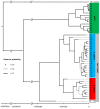Early Pleistocene origin and extensive intra-species diversity of the extinct cave lion
- PMID: 32724178
- PMCID: PMC7387438
- DOI: 10.1038/s41598-020-69474-1
Early Pleistocene origin and extensive intra-species diversity of the extinct cave lion
Abstract
The cave lion is an extinct felid that was widespread across the Holarctic throughout the Late Pleistocene. Its closest extant relative is the lion (Panthera leo), but the timing of the divergence between these two taxa, as well as their taxonomic ranking are contentious. In this study we analyse 31 mitochondrial genome sequences from cave lion individuals that, through a combination of 14C and genetic tip dating, are estimated to be from dates extending well into the mid-Pleistocene. We identified two deeply diverged and well-supported reciprocally monophyletic mitogenome clades in the cave lion, and an additional third distinct lineage represented by a single individual. One of these clades was restricted to Beringia while the other was prevalent across western Eurasia. These observed clade distributions are in line with previous observations that Beringian and European cave lions were morphologically distinct. The divergence dates for these lineages are estimated to be far older than those between extant lions subspecies. By combining our radiocarbon tip-dates with a split time prior that takes into account the most up-to-date fossil stem calibrations, we estimated the mitochondrial DNA divergence between cave lions and lions to be 1.85 Million ya (95% 0.52- 2.91 Mya). Taken together, these results support previous hypotheses that cave lions existed as at least two subspecies during the Pleistocene, and that lions and cave lions were distinct species.
Conflict of interest statement
The authors declare no competing interests.
Figures


References
-
- Bocherens H, et al. Isotopic evidence for dietary ecology of cave lion (Panthera spelaea) in North-Western Europe: prey choice, competition and implications for extinction. Quat. Int. 2011;245:249–261. doi: 10.1016/j.quaint.2011.02.023. - DOI
-
- Antón M, Galobart A, Turner A. Co-existence of scimitar-toothed cats, lions and hominins in the European Pleistocene. Implications of the post-cranial anatomy of Homotherium latidens (Owen) for comparative palaeoecology. Quat. Sci. Rev. 2005;24:1287–1301. doi: 10.1016/j.quascirev.2004.09.008. - DOI
-
- Stuart AJ, Lister AM. Patterns of late quaternary megafaunal extinctions in Europe and northern Asia. CFS Cour. Forschungsinstitut Senckenb. 2007;259:287–297.
-
- Sotnikova M, Nikolskiy P. Systematic position of the cave lion Panthera spelaea (Goldfuss) based on cranial and dental characters. Quat. Int. 2006;142–143:218–228. doi: 10.1016/j.quaint.2005.03.019. - DOI
Publication types
MeSH terms
LinkOut - more resources
Full Text Sources
Medical

